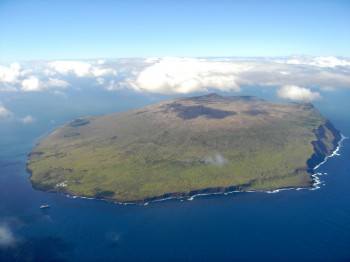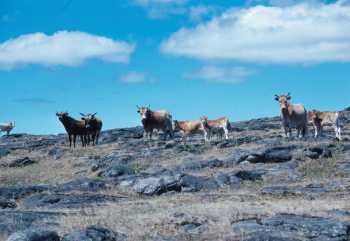
île Amsterdam from the air. Photograph by Thierry Micol
île Amsterdam is part of the French Southern and Antarctic Territories (Terres Australes et Antarctiques Françaises - TAAF). It is an old volcano situated in subtropical waters in the southern Indian Ocean. The 58-km² island is surrounded by cliffs up to 720 m high at Le Pignon except on the north point where the permanent base Martin de Viviès was established in the early 1950s. Since 2006 the whole island and its territorial waters have been classified as a National Nature Reserve. A management plan for the reserve was launched in 2011 for a five-year period. The island was designated as part of a Ramsar Wetland of International Importance in 2006 (click here).
Falaises d’Entrecasteaux. Photograph by Jeremie Demay
Four ACAP-listed species come ashore to breed every year on the island and are monitored annually by CNRS Chizé biologists as part of a long-term scientific research programme from the French Polar Institute Paul-Emile Victor (IPEV). The Amsterdam Albatross Diomedea amsterdamensis breeds between 500 and 700 m high on the Plateau des Tourbières (Peat Bog Plateau), Sooty Albatrosses Phoebetria fusca are scattered along the coastal cliffs and the Indian Yellow-nosed Albatross Thalassarche carteri occupies the south-west of the island on Falaises d’Entrecasteaux.
Amsterdam’s cliffs behind an Amsterdam Albatross in flight. Photograph by Mark Zufelt
The Grey Petrel Procellaria cinerea is a rare winter breeder with only two sites known that hold a handful of pairs (a few birds are seen every year). A fifth ACAP-listed species, the Northern Giant Petrel Macronectes halli, was observed breeding for the first time in 2012.

Indian Yellow-nosed Albatross with chick at Falaises d’Entrecasteaux
Photograph by Jeremie Demay
The most numerous ACAP species is the Indian Yellow-nosed Albatross with 22 000 breeding pairs counted on the Falaises d’Entrecasteaux during the last census in 2012. Regularly monitored colonies indicate an overall decline of 6.7% a year for the period 1987-2013 with a low breeding success, mostly due to failures between hatching and fledging.

Sooty Albatrosses on the Entrecasteaux cliffs. Photograph by Jeremie Demay
The Sooty Albatross population has decreased slightly over the last 15 years, also due to a low breeding success. The last whole island census was made during the 2011/12 breeding season when 394 active nests were recorded after hatching.

Amsterdam Albatrosses at their nest on the Plateau des Tourbières
Photograph by Jeremie Demay
The Amsterdam Albatross is the rarest albatross in the World. The species is classified as Critically Endangered and is endemic to île Amsterdam. Since it was elevated to species rank in 1983 the whole population has been monitored every year. The number of annual breeding pairs increased from 5 to 40 between 1982 and 2012 and the total species population is estimated at 160-170 individuals. A national plan of action has been initiated by the French Ministry in charge of ecology to improve the conservation status of the species (click here).
Feral cattle on île Amsterdam: now eradicated. Photograph by Marc Lebouvier
Since the island was discovered in the 17th Century its ecosystem has been modified by introduced plants, insects and various species of mammals as well as by fires and exploitation of fur seals. Feral cattle Bos taurus were eradicated in 2010 (click here). Norway or Brown Rats Rattus norvegicus, House Mice Mus musculus and feral cats Felis catus remain on the island. The main threat to the albatrosses is the presence of infectious pathogens that cause avian cholera (Pasteurella multocida) or Erysipelas (Erysipelothrix rhusiopathidae).
Selected References:
Decante, F., Jouventin, P.E., Roux, J.-P. & Weimerskirch, H. 1987. Projet d’aménagement de l’île Amsterdam. Rapport SRETIE, TAAF, CEBC-CNRS.
Delord, K., Micol, T. & Marteau, C. (undated). Plan national d’actions pour l’albatros d’Amsterdam Diomedea amsterdamensis 2011 – 2015. La Défense: Ministère de l'Écologie, de l'Énergie, du Développement durable et de l’Énergie. 83 pp.
Delord, K., Micol, T. & Marteau, C. (undated). Taking action for the Amsterdam Albatross. A Synopsis of the National Plan of Actions 2011-2015. La Défense: Ministère de l'Écologie, de l'Énergie, du Développement durable et de l’Énergie. 15 pp.
Duriez, O. & Delord, K. 2012. Manchots, petrels et albatross : oiseaux des Terres australes et antarctiques françaises (TAAF). Ornithos 19-3: 162-183.
Duriez, O., Jornvaal, H. & Shirihai, H. 2005. Birds and wildlife of the French sub-Antarctic islands: Crozet, Kerguelen and Amsterdam & St Paul. Dutch Birding 27: 87-115.
Inchausti, P. & Weimerksirch, H. 2001. Risks of decline and extinction of the endangered Amsterdam albatross and the projected impact of long-line fisheries. Biological Conservation 100: 377–386.
Jouventin, P. 1994. Past, present and future of Amsterdam Island (Indian Ocean) and its avifauna. BirdLife Conservation Series 1: 122-132.
Jouventin, P. & Roux, J.-P. 1983. Discovery of a new albatross. Nature 305: 181.
Jouventin, P., Martinez, J. & Roux, J.-P. 1989. Breeding biology and current status of the Amsterdam Island Albatross Diomedea amsterdamensis. Ibis 131: 171-182.
Micol, T. & Jouventin, P. 1995. Restoration of Amsterdam Island, South Indian Ocean, following control of feral cattle. Biological Conservation 73: 199-206.
Ministère de l'Écologie et du Développement Durable 2008. Décret No. 2006-1211 du 3 octobre 2006 portant creation de la reserve naturelle des Terres australes françaises. Journal Officiel de la République Française. 4 octobre 2006. 4 pp.
Rivalan, P., Barbraud, C., Inchausti, P. & Weimerskirch, H. 2010. Combined impact of longline fisheries and climate on the persistence of the Amsterdam Albatross. Ibis 152: 6-18.
Rolland, V., Barbraud, C,. & Weimerskirch, H. 2009. Assessing the impact of fisheries, climate and disease on the dynamics of the Indian yellow-nosed Albatross. Biological Conservation 142: 1084-1095.
http://www.cebc.cnrs.fr/publipdf/2009/RBC142_2009.pdf
Roux, J.-P., Jouventin, P., Mougin, J-.L., Stahl, J.S. & Weimerskirch, H. 1983. Un nouvel albatros Diomedea amsterdamensis n. sp. Découvert sur l’île Amsterdam (37°50’S, 77°35’E). L’Oiseau et R.F.O. 53: 1-11.
TAAF 2006. Instructions sur la protection de l'environnement dans les Terres australes antarctiques françaises. Saint-Pierre: Terres australes et antarctiques françaises. 9 pp.
TAAF 2010. Plan de gestion 2011 - 2015 Réserve naturelle des Terres australes françaises. Saint Pierre, La Réunion: Terres australes et antarctiques françaises. 35 pp.
Wiemerskirch, H. 2004. Diseases threaten Southern Ocean albatrosses. Polar Biology 27: 374-379.
Weimerskirch, H., Brothers, N. & Jouventin, P. 1997. Population dynamics of wandering albatrosses Diomedea exulans and Amsrerdam albatrross D. amsterdamensis in the Indoan Ocean and their relationship with longline fisheries: conservation implications. Biological Conservation 79: 257-270.
Fabrice Le Bouard, Centre d'Etudes Biologiques de Chizé, Villiers-en-Bois, Beauvoir-sur-Niort, France, 01 July 2013

 English
English  Français
Français  Español
Español 

